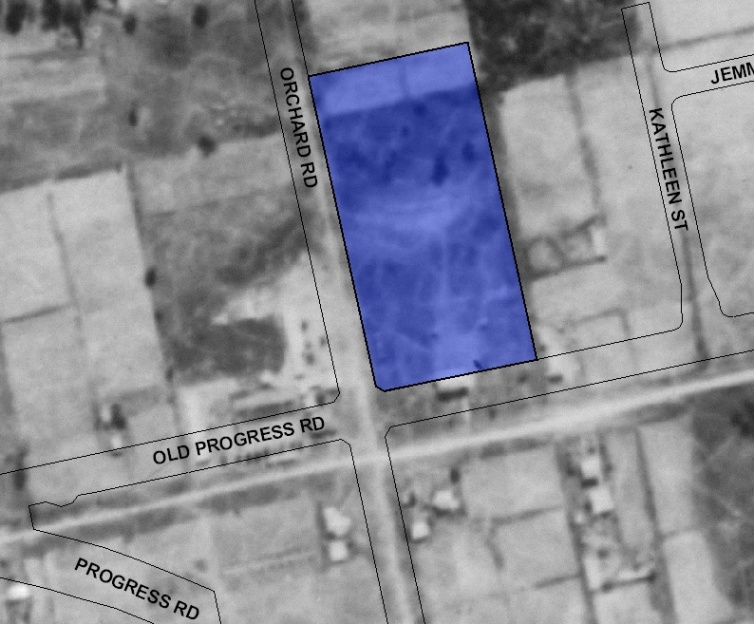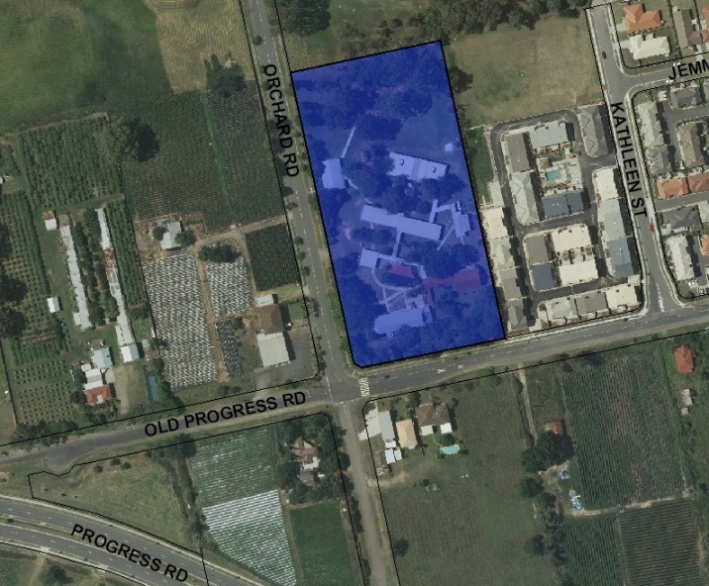Addresses
Type of place
Monument / memorial, State school
Period
Interwar 1919-1939
Style
Bungalow
Addresses
Type of place
Monument / memorial, State school
Period
Interwar 1919-1939
Style
Bungalow
The Richlands State School was built in 1934 after community concern about lack of educational facilities in the vicinity. The design of the school followed the Works Department’s plans for Sectional Schools. Demonstrative of the growth of the Richlands community the original one classroom timber building was subsequently expanded in 1938 and again in the 1950s. Within the school grounds a Memorial for the pioneering families of the area has been erected, a reflection of the pride the community feels for their history.
Lot plan
L27_RP50038
Key dates
Local Heritage Place Since —
Date of Citation —
Construction
Roof: Corrugated iron;Walls: Timber
Criterion for listing
(A) Historical; (D) Representative; (E) Aesthetic; (G) SocialInteractive mapping
Lot plan
L27_RP50038
Key dates
Local Heritage Place Since —
Date of Citation —
Construction
Roof: Corrugated iron;Walls: Timber
Criterion for listing
(A) Historical; (D) Representative; (E) Aesthetic; (G) SocialInteractive mapping
History
The Richland’s area was first settled by Europeans in the mid-nineteenth century. Initially the land formed part of Dr. Stephen Simpson’s cattle and horse breeding station ‘Woogaroo’. In 1859 approximately 15, 000 acres of this property was purchased by Mr. Farleigh. The holding was named ‘Archerfield’ and incorporated the area now known as Richlands and Inala. Unfortunately the homestead burnt down in the 1930s. By the 1890s smaller land holdings were purchased for farming in the Richlands area.
In the 1920s Richlands became home to many Italian migrants. Many had family connections in the sugar industry in North Queensland or in the fruit-growing region of Stanthorpe. A tightly knit community developed due to the increased migrant settlement. Much of the Richlands area became market gardens for the Italian migrants and importantly was one of the first areas in South East Queensland to establish vineyards. Some managed to work at places such as Queensland Cement and Lime or the brickworks at Darra while they were establishing their properties. Crops such as strawberries and various vegetables were grown on the farms and several poultry farms were set up. One poultry farm in particular owned by the Sappanen family became the largest in Queensland. By the end of the 1920s there were approximately seventy-five homes and farms in the Richlands area.
As the population of Richlands increased so too did the need for educational facilities for the resident’s children. Although many of the children in the area attended school at Darra they had to walk over three miles to get there and back on an unsafe and busy road. For the smaller children of school age this was impossible. The results of a survey carried out in 1933 ascertained that there were thirty-four children in the Richlands area between the ages of five and eleven. In May 1933 a Memorandum was received by the Director of Education requesting the establishment of a school in Richlands from Mr. T. Nimmo, M. L. A and representative for the Richlands area. It stated that if the Department of Education could supply the material for the school then the land would be donated by the community. This was agreed to by the Department of Public Instruction and the Department of Public Works and in January 1934 a letter was sent to Mr. Nimmo advising of the erection of a school at Richlands. It stated “The building will be of the sectional type, size 21’ by 18’ with 8’ verandahs on two sides, and will be constructed of wood, with iron roof”.
The land on which the school was to be built was donated to the Richlands community by the Brisbane Estates Company. The estate on which the donated school land was situated was subdivided by the Brisbane Estates Company and sold as farmlets “suitable tobacco, pines, fruit, market gardens, pig and poultry & bee farming”. Most lots were approximately four acres. The lot reserved for the school, Lot 27 of Portion 366, consisted of four acres and six perches of land on the corner of Orchard and Progress Road.
The plan for the timber, one classroom building with verandah on front and end, was drawn up by the Works Department and followed the design specifications laid down by the Department of Public Instruction in this period. These specifications followed a generic design that had been developed by the Works Department. This new type of permanent timber school was known as the Sectional School. The design was based on the building of a centre building with one or two classrooms. The structure was designed to allow easy extension of the building progressively. This was possible due to a detachable end wall that could be included as part of an extension. The generic nature of the Sectional School’s design included the school being high set on timber stumps with front and side verandahs, weatherboard exterior cladding, folding partition internal walls, tongue and groove timber wall lining, and large panels of timber windows to allow in natural light. In the 1929 Annual Report for the Department of Public Instruction this new school design was described as “an attractively designed structure, well ventilated and lighted, and apparently admirably well suitable for the tropical weather conditions.” The practical design of the school was designed around climactic and lighting considerations in Queensland.
At the time the school was opened the majority of the families living in Richlands in this era were extremely poor. In a Memorandum dated September 1934 from the Department of Public Instruction to the Director of Education it was stated that due to the harsh economic times many of the male residents worked as relief workers in the government relief schemes as well as attempting to utilise their land holdings for the cultivation of small crops. The concern was that the children from this district were suffering from symptoms of malnutrition caused by poverty and that government assistance in health care and nutrition for these children was required, “otherwise [the children] cannot be expected to develop into anything like reasonably healthy citizens”. The Memorandum stated that the appearance of a large number of children at the school indicated “the nutritional value of the food must be very poor. Most of the children are of that type describes medically as “pot-bellied”, are undersized, with pipe-stem limbs; they are pale and many of them are listless”. The Memorandum goes on to describe the unhygienic state that many of the children were in, “the children’s bodies look as if they have not been properly washed for quite a long period”. Skin diseases and vermin plagued the children. The Memorandum clearly stated that the unfortunate state of the children’s health was not attributable to parental neglect; instead it was due to the harsh economic times and the lack of a constant water source, “In most cases, the parents have tried hard to keep the children neatly dressed… The homes in most instances are extremely neat and well kept”. A request was made to the Works Department to donate old water tanks for the struggling residents, and a request was made for regular visits from a doctor and a dentist to the school.
Although the fledgling school community struggled financially it was a close knit one. Much voluntary work was done to the school in its first few years by parents and friends including establishing gardens throughout the school yard, erecting a flag pole and basket ball courts, and gravelling underneath the school building. Relief Workers also contributed to the school by clearing much of the school land.
The school committee’s fund raising attempts initially proved to be a controversial topic amongst Richlands residents in the early years of the school. In 1935 a complaint was made to the Director of Education against the Richlands School Committee in relation to the fund raising or ‘dance’ evenings held at the school. A petition was presented and signed by the parents of twenty-five of the thirty-nine pupils at the school complaining of the committee’s activities, “The method of raising funds by allowing drinking, fighting, foul language…is not desirable and cannot be tolerated by any respectable person”. The head teacher of the school also believed that the ‘evenings’ should cease as they were not altogether appropriate. The committee was disbanded and another elected. Nevertheless the school community grew and strengthened.
In 1938 extensions were made to the small school building due to increased enrolment numbers. Once again Mr. Nimmo was instrumental in gaining the extension. In November 1938 the Department of Public Works wrote to Mr. Nimmo advising him of the approval for the extensions, it stated “The work will comprise the addition of a 21’ x 18’ classroom, with 8’ verandahs front and side, new folding partition between classrooms, and a hat room on side verandah”. One extra room was added with extended front verandah and extra side verandah.
Urban development began with the end of the Second World War. The post-war housing shortage and the need to house returning servicemen led to the acquisition and development of land in Inala by the newly formed Queensland Housing Commission. Much of the housing erected by the Housing Commission during the 1950s and 1960s was designed to be assembled rapidly, rather than to last. Inala, originally known as ‘Serviceton’, was developed by the Queensland Housing Commission as part of its plan to locate workers’ housing near industry. This strategy had both positive and negative effects. It led to a close-knit community with a high level of local pride and commitment but troubled by geographic isolation and limited access to employment, shopping and other essential services. The population in the area increased and so too did enrolments at the Richlands State School.
With the Sectional design of the building the school was able to be further extended in 1952 with the adding of another room, again in 1953 with two more rooms, and again in 1954 with two more. Each extension was deemed necessary due to the increase in student numbers.
The Richlands and Inala areas have a diverse multi-cultural population influenced by the Wacol Migrant Centre that was situated on the opposite side of Ipswich Road to the Army Barracks. Many migrants from places such as Europe, South America and Indochina were temporarily placed in the Centre on their arrival to Australia after the Second World War. From there many established new lives in adjacent suburbs that were familiar to them such as Inala, Richlands and Darra. Within the grounds of the school the Richlands community have erected a memorial to the Italian pioneers in the area, a reminder of the continued community pride felt by Richlands residents.
Statement of significance
Relevant assessment criteria
This is a place of local heritage significance and meets one or more of the local heritage criteria under the Heritage planning scheme policy of the Brisbane City Plan 2014. It is significant because:
References
-
Annual Report for the Department of Public Instruction 1929, p. 101.
-
Burmester, Paul, Margaret Pullar and Michael Kennedy. Queensland Schools: A Heritage conservation Study, Brisbane: Department of Education, 1996
-
Brisbane City Council, Properties on the Web, website
-
Brisbane City Council, 1946 aerial photographs.
-
Department of Natural Resources, Queensland Certificates of title and other records.
-
Queensland Post Office Directories, 1868-1949
-
Richlands State School, State Archives File
-
Richlands State School: 60th Anniversary, 1934-1994
Citation prepared by — Brisbane City Council (page revised June 2022)

